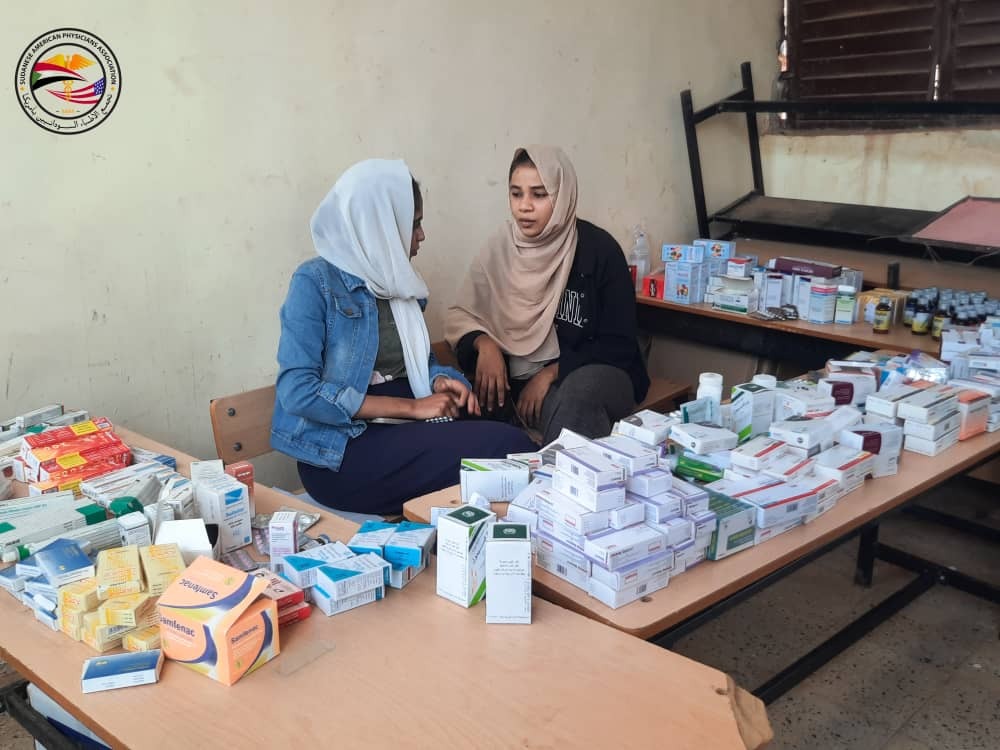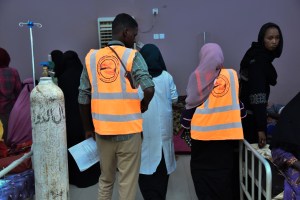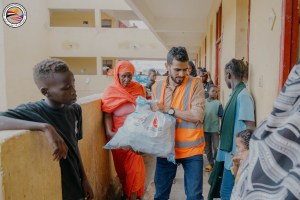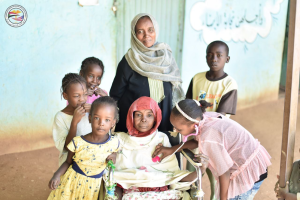Sudan Crisis: Current Realities & Historical Background [4 Facts]
In recent years, Sudan has found itself trapped in a multifaceted crisis that demands urgent attention from the international community. The crisis has its roots in a complex interplay of political, economic, and humanitarian factors, creating a volatile mix that has left millions of Sudanese citizens grappling with adversity. As the world navigates its challenges, it becomes imperative to shine a spotlight on Sudan’s Humanitarian Crisis and collectively explore avenues for support and resolution.
Four things to know about the Sudan Crisis:
The crisis in South Sudan, ongoing since the Darfur conflict erupted in 2003, continues to cause immense suffering and displacement. Here are four key points you need to know about this complex situation:
1. Massive Displacement: By the end of 2022, over 3.7 million people were internally displaced within Sudan, a majority residing in camps across Darfur. Additionally, an estimated 800,000 Sudanese sought refuge in neighboring countries like Chad, South Sudan, Egypt, and Ethiopia.
2. Compounded Humanitarian Needs: The current conflict, involving the Sudanese Armed Forces and the paramilitary Rapid Reaction Forces, exacerbates already dire humanitarian needs. Fighting erupted amidst Sudan’s highest levels of humanitarian need in a decade, with 4.5 million people already internally displaced prior to the conflict.
3. Urgent Need for Aid: The combined effects of internal displacement, refugee influx, and ongoing conflict create an urgent need for increased international aid. Resources are desperately needed to provide basic necessities like food, shelter, and medical care to millions of affected individuals.
4. Fear of Mass Exodus: UNHCR, the UN Refugee Agency, estimates that over 1.8 million people could flee Sudan in search of safety in neighboring countries. This potential mass exodus necessitates immediate action and increased support to avert a humanitarian catastrophe.
Beyond these four crucial points, it’s important to remember the human cost of the conflict. Millions of lives have been disrupted, families separated, and communities destroyed. Understanding the complexities of the situation and advocating for increased aid are essential steps towards alleviating suffering and paving the path towards a peaceful resolution.
Sudan Crisis Explained
The Sudan crisis is a complex issue rooted in a long history of political, social, and economic challenges. To understand the current crisis, it’s crucial to delve into the historical background of Sudan.
Colonial Legacy (19th and 20th centuries)
Sudan, located in northeastern Africa, was historically home to diverse cultures and civilizations. During the 19th and 20th centuries, Sudan fell under British and Egyptian colonial rule, contributing to ethnic and religious tensions.
Independence and Civil Wars (1956-2005)
Sudan gained independence in 1956, but internal conflicts soon erupted. The First Sudanese Civil War (1955-1972) and the Second Sudanese Civil War (1983-2005) were driven by issues such as ethnic divisions, economic disparities, and religious differences between the Arab-Muslim north and the predominantly Christian and animist south.
Formation of South Sudan (2011)
The Second Sudanese Civil War eventually led to the Comprehensive Peace Agreement (CPA) in 2005, culminating in the secession of South Sudan in 2011. The birth of South Sudan as an independent nation was aimed at resolving longstanding issues, but it also left behind unresolved challenges in the rest of Sudan.
Darfur Conflict (2003-2010)
Concurrently, the Darfur conflict unfolded in western Sudan, marked by violence between government forces and rebel groups. The conflict resulted in widespread displacement and humanitarian crises, attracting international attention and criticism.
Ongoing Challenges (2011-Present)
Post-independence, Sudan continued to grapple with economic instability, political unrest, and conflicts in regions like the Nuba Mountains and Blue Nile. In 2019, protests erupted, leading to the ousting of President Omar al-Bashir. However, the transition to civilian rule has been tumultuous.
What is Happening in South Sudan?
The nation has faced a series of conflicts, including the Darfur crisis and the secession in 2011, leading to numerous South Sudan Refugees in Sudan refugee camps. Political instability, economic mismanagement, and ethnic tensions have fueled a cycle of violence and displacement, leaving the country in a precarious state.
The Economic Quandary
One of the pillars of the Sudan crisis 2023 is the dire economic situation. The collapse of the Sudanese economy has led to soaring inflation, widespread poverty, and a shortage of essential commodities. The citizens bear the brunt of these economic woes, struggling to afford necessities like food and medicine. Unemployment rates have surged, exacerbating the already precarious living conditions for many.
Political Turmoil
Sudan has experienced a tumultuous political landscape marked by coups, authoritarian rule, and protests. The ousting of longtime President Omar al-Bashir in 2019 fueled hope for a democratic transition. However, the transitional government has encountered numerous challenges in its efforts to steer the country toward stability. Political divisions persisted, hindering the establishment of a cohesive and effective administration, resulting in the Sudan Civil War.
Humanitarian Crisis
The Sudan crisis has given rise to a severe humanitarian situation, with millions of people in need of assistance. Armed conflicts, displacement, and Hunger in Sudan due to food insecurity have contributed to a growing number of internally displaced persons (IDPs) and refugees. Humanitarian organizations face obstacles in delivering aid due to insecurity and limited resources, leaving vulnerable populations on the brink of a humanitarian catastrophe.
The Role of Climate Change
In addition to the socio-political factors, climate change has exacerbated the crisis in Sudan. The country is experiencing more frequent and intense climate-related events, including droughts and floods. These environmental challenges have severe implications for agriculture, exacerbating food insecurity and further destabilizing the economy.
International Response
Addressing the Sudan IDPs crisis requires a coordinated and robust international response. The United Nations, the African Union, and other regional bodies play a crucial role in facilitating dialogue, peacekeeping, and humanitarian assistance. The international community must rally together to provide financial support, technical expertise, and diplomatic resources to aid Sudan in its journey toward stability.
The Importance of Diplomacy
Diplomacy is crucial in resolving the Sudan crisis 2023. The international community should actively engage with Sudanese stakeholders to foster dialogue and reconciliation. Inclusive peace talks involving various ethnic and political groups are essential for building a sustainable foundation for the country’s future. External actors must respect Sudan’s sovereignty while providing support that aligns with the aspirations of its people.
Economic Aid and Development Initiatives
To address the economic challenges, international donors can contribute to comprehensive economic reform programs. Supporting initiatives that focus on job creation, infrastructure development, and sustainable agriculture can help revitalize the Sudanese economy. Additionally, Sudan relief fund and other and financial assistance can alleviate immediate economic pressures, allowing the government to invest in long-term development.
Humanitarian Assistance and Refugees Crisis IDPs
Humanitarian organizations must be empowered to deliver aid effectively. Increased funding, improved infrastructure, and enhanced security measures are essential for ensuring the timely and safe distribution of humanitarian assistance. The international community should also collaborate to address the needs of Sudanese refugees, both within the country and in neighboring nations.
Regional Dynamics and Peacekeeping
Sudan’s crisis doesn’t exist in isolation; it is deeply intertwined with regional dynamics. Protracted conflicts in neighboring countries, such as South Sudan and Chad, have contributed to cross-border insecurity and the movement of refugees. The international community, through regional bodies like the African Union, should foster collaborative efforts to address the interconnected challenges in the region. This might involve joint peacekeeping operations, intelligence-sharing, and regional economic initiatives that promote stability.
Women’s Rights and Inclusion
Sudanese women have been at the forefront of advocating for change. Their participation in political processes and peacebuilding efforts is crucial for sustainable development. International support should be directed towards initiatives that promote gender equality, protect women’s rights, and ensure their meaningful inclusion in decision-making processes. This includes supporting education programs for girls, healthcare initiatives, and economic empowerment projects that uplift women and contribute to broader societal resilience.
Media Freedom and Information Dissemination
Access to accurate information is a cornerstone of any democratic society. Supporting and safeguarding media freedom in Sudan is essential for informing the public, fostering transparency, and holding authorities accountable. International organizations can assist in building the capacity of local media outlets, promoting ethical journalism, and ensuring that diverse voices are heard. This contributes to the creation of an informed citizenry that actively engages in the democratic process.
Cultural Preservation and Heritage Protection in Sudan
Sudan boasts a rich cultural heritage that has been threatened by years of conflict. International assistance can play a role in preserving and protecting Sudan’s cultural treasures. This includes supporting initiatives for the restoration of historical sites, the digitization of cultural artifacts, and the promotion of cultural exchange programs. Safeguarding Sudan’s heritage not only contributes to national identity but also fosters a sense of pride and resilience among its people.
Sudan Crisis 2024: Deepening Despair in a Fragile Nation
The year 2024 has brought little respite to the people of Sudan, whose nation remains engulfed in a devastating crisis. The ongoing conflict, which erupted in 2003, continues to cast a long shadow over the lives of millions, leaving a trail of displacement, suffering, and despair.
A Glimmer of Hope?
Despite the immense challenges, there have been some glimmers of hope in 2023. The United Nations Mission in South Sudan (UNMISS) has called for increased efforts to address the crisis, including prioritizing peace negotiations, strengthening humanitarian response, and upholding human rights. Furthermore, several international organizations and NGOs are working tirelessly on the ground to assist those affected by the conflict.
The Road Ahead for Sudan Conflict in 2024:
Resolving the Sudan crisis will require a sustained and coordinated effort from all stakeholders. The international community must play a vital role by:
- Providing increased humanitarian aid: This includes funding for food, shelter, healthcare, and supporting initiatives like Water for South Sudan.
- Supporting peace negotiations: The international community must exert pressure on the warring parties to reach a lasting ceasefire and engage in meanihttps://sapa-usa.org/washngful peace talks.
- Holding perpetrators accountable: Those responsible for human rights violations must be held accountable to ensure justice and deter future abuses.
The people of Sudan deserve a future free from violence and despair. Only through sustained international support and a genuine commitment to peace can this war-torn nation begin to heal and rebuild.
Conclusion: A Holistic Approach for Sudan’s Renewal
In conclusion, addressing the Sudan crisis 2023 requires a holistic and multi-faceted approach. The international community must recognize the interconnected nature of the challenges facing Sudan and tailor its support accordingly. From regional collaboration and peacekeeping efforts to empowering marginalized groups, investing in education, and preserving cultural heritage, a comprehensive strategy is needed. By combining diplomatic, economic, humanitarian, and developmental initiatives, the global community can contribute to Sudan’s renewal, offering hope for a brighter and more stable future. In doing so, we affirm our commitment to the principles of justice, peace, and the collective well-being of all nations. To help the locals of Sudan, donate to SAPA, which is creating a lasting impact on real people.
FAQS
Why Does Sudan Have So Many Refugees?
- Historical Conflicts: Sudan has a history marked by conflicts, including the Darfur crisis and the civil war that led to the secession of South Sudan in 2011. These conflicts have resulted in the displacement of millions, both internally and across borders.
- Ethnic and Political Tensions: Ethnic and political tensions have contributed to a volatile environment, prompting people to flee their homes in search of safety and stability.
- Economic Instability: The economic challenges in Sudan, characterized by high inflation and unemployment rates, have driven many to seek better opportunities elsewhere.
- Climate Change Impact: Sudan is grappling with the effects of climate change, including droughts and floods, which have led to environmental degradation and food insecurity, further contributing to displacement.
- Limited Access to Basic Services: Challenges in providing basic services such as healthcare and education have forced some Sudanese to seek refuge in countries with more stable infrastructures.
How Many Refugees Are in Sudan?
- Internal Displacement: By the end of 2022, over 3.7 million people were internally displaced within Sudan, a majority residing in camps across Darfur. Sudan hosts a significant number of internally displaced persons (IDPs) due to various conflicts and natural disasters.
- Refugees from South Sudan: The secession of South Sudan in 2011 resulted in the displacement of people across the newly formed border. Sudan is home to a substantial number of South Sudanese refugees, with estimates exceeding a million.
- Darfur Crisis: The Darfur conflict, which began in the early 2000s, has led to a large population seeking refuge within Sudan and in neighboring countries. The number of Darfuri refugees remains significant.
- Eritrean and Ethiopian Refugees: Sudan hosts refugees from neighboring countries like Eritrea and Ethiopia, escaping conflict and persecution. The precise number can vary but is substantial.
- Ongoing Influx: Sudan continues to receive new refugees due to ongoing conflicts, making it challenging to provide an exact number. International organizations and Sudanese authorities work together to assess and address the needs of refugees in the country.






